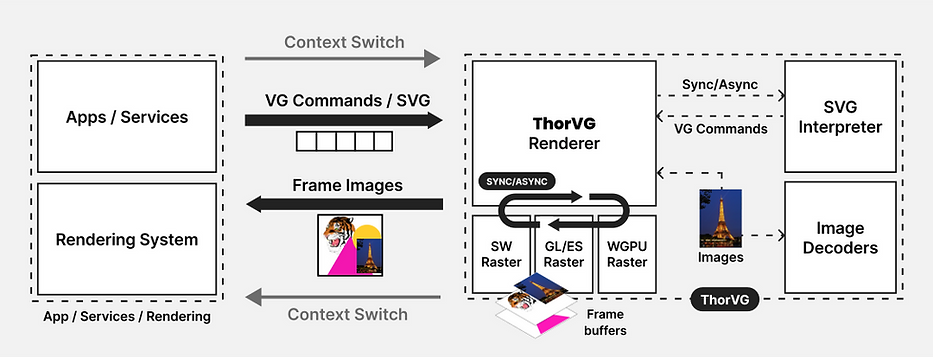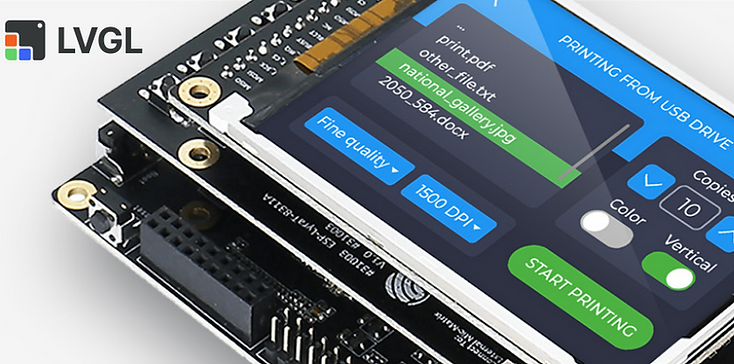About ThorVG
Thor Vector Graphics is an open-source graphics library designed for creating vector-based scenes and animations. It combines immense power with remarkable lightweight efficiency, as Thor embodies a dual meaning—symbolizing both thunderous strength and lightning-fast agility. Embracing the philosophy of simpler is better, the ThorVG project provides intuitive, user-friendly interfaces while maintaining a compact footprint and minimal overhead.
The following list shows primitives that are supported by ThorVG:
-
Lines & Shapes: rectangle, circles, and paths with coordinate control
-
Filling: solid colors, linear & radial gradients, and path clipping
-
Stroking: stroke width, join, cap, dash patterns, and trimming
-
Scene Management: retainable scene graph & object transformations
-
Composition: various blending and masking
-
Text: unicode characters and horizontal text layout using the scalable fonts (TTF)
-
Images: SVG, JPG, PNG, WebP, Raw Bitmap
-
Effects: blur, drop shadow, tint, tritone and color replacement
-
Animation: Lottie

Anti-aliased Shapes

Path-Clipping

Blending

Gaussian-Blur

Gradient Filling

SVG

Texturing

Drop-Shadow

Stroking

Masking

Text

Color Replacement
Supported Platforms
ThorVG is designed to be portable across a wide range of devices, including small IoT devices, embedded systems, mobile platforms, desktop environments, and the web. It is actively under development, with ongoing efforts to expand support for essential platforms as needed. Currently, major supported platforms include:

Linux
MacOS
Windows
Tizen
iOS
Android
Web
Flutter
OpenVela
Godot
Expressif
NuttX
Structural Design
ThorVG is designed for a wide range of programs, offering adaptability for integration and use in various applications and systems. It achieves this through a single binary with selectively buildable, modular components in a building block style. This ensures both optimal size and easy maintanence.

If your program includes the main renderer, you can seamlessly utilize ThorVG APIs by transitioning drawing contexts between the main renderer and ThorVG. Throughout these API calls, ThorVG effectively serializes drawing commands among volatile paint nodes. Subsequently, it undertakes synchronous or asynchronous rendering via its backend raster engines. Additionally, ThorVG is adept at handling vector images, including formats like SVG, and it remains adaptable for accommodating additional popular formats as needed. In the rendering process, the library may generate intermediate frame buffers for scene compositing, though only when essential. The accompanying diagram provides a concise overview of how to effectively incorporate ThorVG within your system.

Render Backends
Today, ThorVG provides its own implementation of multiple raster engines, allowing you to choose the one that best suits your app and system preferences.
-
CPU/SIMD (Software)
-
OpenGL/ES
-
WebGL
-
WebGPU
ThorVG is ahead of the curve, particularly in the web ecosystem. WebGPU introduces next-generation APIs similar to Vulkan, leveraging compute shaders and providing low-overhead, modern GPU access for more aggressive optimization strategies and broader applications. Building on this, ThorVG fully supports vector rendering features within its specification on top of WebGPU. Additionally, by abstracting underlying hardware graphics accelerations such as Metal, Vulkan, and DirectX, ThorVG ensures seamless adoption across various systems, regardless of the installed hardware accelerations.

Threading
ThorVG incorporates a threading mechanism that aims to seamlessly acquire subsequent scenes without unnecessary delays. It operates using a finely-tuned task scheduler based on thread pools, encompassing various tasks such as encoding, decoding, updating, and rendering. This design ensures that all tasks can effectively leverage multi-processing capabilities.
The task scheduler has been meticulously crafted to conceal complexity, streamline integration, and enhance user convenience. Therefore, the policy it employs is optional, allowing users to select it based on their specific requirements.

Smart Rendering
ThorVG supports smart partial rendering, which enables more efficient rendering workflows by updating only the portions of a vector scene that have changed. By internally tracking modified regions, it minimizes unnecessary redraws and optimizes overall performance. This feature provides significant benefits in scenarios such as UI rendering, design tools, or applications where large parts of the scene remain static and only small elements update between frames. In such cases, avoiding full-scene rendering can greatly reduce computational workload and improve energy efficiency—making it particularly valuable on mobile and embedded systems.
The following figure illustrates the geometry changes and highlights the minimal redraw region (outlined in red) that needs to be updated. Only the modified area between the previous and current frames is selectively redrawn, significantly improving performance.

Please note that in highly dynamic content—such as fast-paced games or full-screen animations where nearly all objects change every frame—partial rendering provides little to no benefit and may even introduce minor overhead. In these scenarios, full-scene rendering is typically the better choice. For a practical showcase, visit this page demonstrating a performance comparison of partial rendering using ThorVG's software renderer.
SVG
ThorVG facilitates SVG (Scalable Vector Graphics) rendering via its dedicated SVG interpreter. Adhering to the SVG Tiny Specification, the implementation maintains a lightweight profile, rendering it particularly advantageous for embedded systems. While ThorVG comprehensively adheres to most of the SVG Tiny specs, certain features remain unsupported within the current framework. These include:
-
Animation
-
Interactivity
-
Multimedia

SVG rendering capabilities as highlighted by ThorVG
Lottie
ThorVG supports the most powerful Lottie Animation features (see dotLottie Player). Lottie is an industry standard, JSON-based vector animation file format that enables seamless distribution of animations on any platform, akin to shipping static assets. These files are compact and compatible with various devices, scaling up or down without pixelation. With Lottie, you can easily create, edit, test, collaborate, and distribute animations in a user-friendly manner. For more information, please visit Lottie Animation Community' website.
Lottie animations powered by ThorVG
Please check out the ThorVG Test to see the performance of various Lottie Animations powered by ThorVG.
ThorVG Viewer
ThorVG provides the resource verification tool for the ThorVG Engine. It does immediate rendering via web browser running on the ThorVG web-assembly binary, allowing real-time editing of the vector elements on it. It doesn't upload your resources to any external server while allowing to export to supported formats such as GIF, so the designer resource copyright is protected.
In Practice
The following list showcases various practical examples of ThorVG in use.
Canva iOS
Canva, a leading visual communication platform, is a household name among creators, marketers, designers, students, and more, with millions of users worldwide. It empowers users to create stunning visual content with a user-friendly interface and a vast library of templates and design elements. The Canva iOS app transitioned from the existing Lottie animation engine to ThorVG for Lottie animations, resulting in approximately an 80% improvement in rendering speed and a 70% reduction in peak memory usage.

dotLottie
dotLottie is an open-source file format that aggregates one or more Lottie files and their associated resources, such as images and fonts, into a single file. This enables an efficient and easy distribution of animations. dotLottie files are ZIP archives compressed with the Deflate compression method and carry the file extension of “.lottie”. Think of it as a superset of Lottie. LottieFiles aims to achieve just that. dotLottie player by LottieFiles is now powered by ThorVG.

Flux Audio
Flux is a cutting-edge audio technology company specializing in high-fidelity sound systems and immersive audio experiences. With a focus on delivering precision and quality, Flux Audio leverages advanced software solutions to enhance audio processing across a wide range of devices. ThorVG is integrated into the user interface of Flux products, providing efficient and scalable vector rendering for their visual elements, ensuring a sleek and responsive user experience. This collaboration highlights ThorVG’s versatility in high-performance audio platforms.

Godot
ThorVG has been integrated into the Godot project to enable the creation of sleek and visually appealing user interfaces (UIs) and vector resources in the Godot game engine. Godot is a modern game engine that is both free and open-source, offering a comprehensive range of tools. With Godot, you can concentrate on developing your game without the need to recreate existing functionalities.

Lottie Creator
Lottie Creator is designed to create ultra-lightweight, highly customizable and interactive animations for web, apps and social. Supercharged with AI-based Motion Copilot. ThorVG is powering the Canvas engine behind Lottie Creator — enabling fast and scalable vector graphics rendering across platforms.

LVGL
LVGL is an open-source graphics library specifically designed for embedded systems with limited resources. It is lightweight and highly customizable, providing support for graphical user interfaces (GUIs) on microcontrollers, IoT devices, and other embedded platforms. ThorVG serves as the vector drawing primitives library in the LVGL framework.

Tizen
ThorVG has been integrated into the Tizen platform as the vector graphics engine. NUI is the name of Tizen UI framework which is written in C#. ThorVG is the backend engine of the NUI Vector Graphics which is used for vector primitive drawings and scalable image contents such as SVG and Lottie Animation among the Tizen applications.

Interactive App
Check out Thor Janitor, an interactive demo game fully rendered using ThorVG. It renders tens of thousands of objects in real-time with effects like DropShadow and Blur, running stably at 120+ FPS!

Contributors
ThorVG stands as a purely open-source initiative. We are grateful to the individuals, organizations, and companies that have contributed to the development of the ThorVG project. The dedicated efforts of the individuals and entities listed below have enabled ThorVG to reach its current state.
-
LottieFiles by Design Barn Inc.
-
Samsung Electronics Co., Ltd
Sponsors
We extend our gratitude to our financial sponsors, whose generous support empowers the ThorVG project. Their funding enables us to continually enhance and expand this open-source project, making it more powerful, efficient, and accessible for the entire community.
We are also seeking your support to ensure the continued development of the ThorVG project. Your generous donations will help cover operational costs and contribute to the growth of this open-source project. Even a small contribution can make a big difference in securing the future of ThorVG!
